Seakeeper 2 Operation Manual (90489-2); S/N 2-203-0400 to 2-232-1563
Seakeeper 2 Operation Manual (90489-2); S/N 2-203-0400 to 2-232-1563
Introduction
Seakeeper 2 Operation Manual
90489
Revision 2
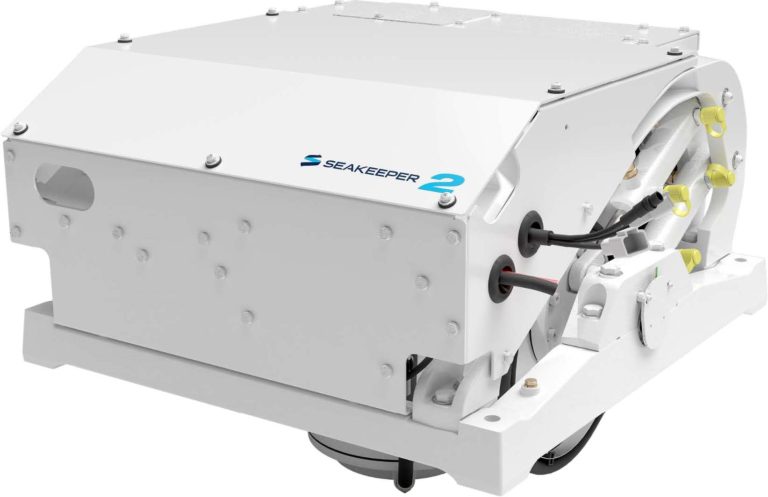
This manual covers the operation of Seakeeper 2 models (2-203-0400 to 2-232-1563).
System Overview
System Overview Introduction
The Seakeeper 2 uses gyroscopic principles to reduce boat roll motions in waves and wakes independent of boat speed. In installations involving multiple Seakeepers, each Seakeeper operates independently of one another; therefore this manual only discusses the operation of a single unit.
A Seakeeper 2 consists of a Gyro assembly, a CAN communications cable, and a Display. Figure 1 illustrates the interconnection of these components and their interface with the boat.

Seakeeper 2 technical specifications provided in Section: Specifications and Summary, list the power consumption, total weight, and dimensions of the major components. Gyroscopic principals that apply to boat roll control are discussed on Seakeeper ’s website at www.seakeeper.com. The Seakeeper website also contains videos of Seakeeper operation and a variety of different boats operating in waves with the Seakeeper
on and off. It is recommended that the reader play these videos prior to reading the remainder of this manual.
The gimbal angle and the rate of rotation about the gimbal axis (termed precession rate) play an important role in its operation. These parameters are illustrated in Figure 2. At zero degree gimbal angle, the sphere is vertical; it can precess a maximum of +/- 68 degrees about this position. The amount of torque that the
Seakeeper exerts on a boat’s hull to counter the wave induced roll is directly proportional to the precession rate. The farther the Seakeeper is from vertical (zero degrees) the lower the anti-roll torque. The vertical arrows in Figure 2 illustrate the direction of the forces that the Seakeeper exerts on the boat’s hull to damp roll motion.
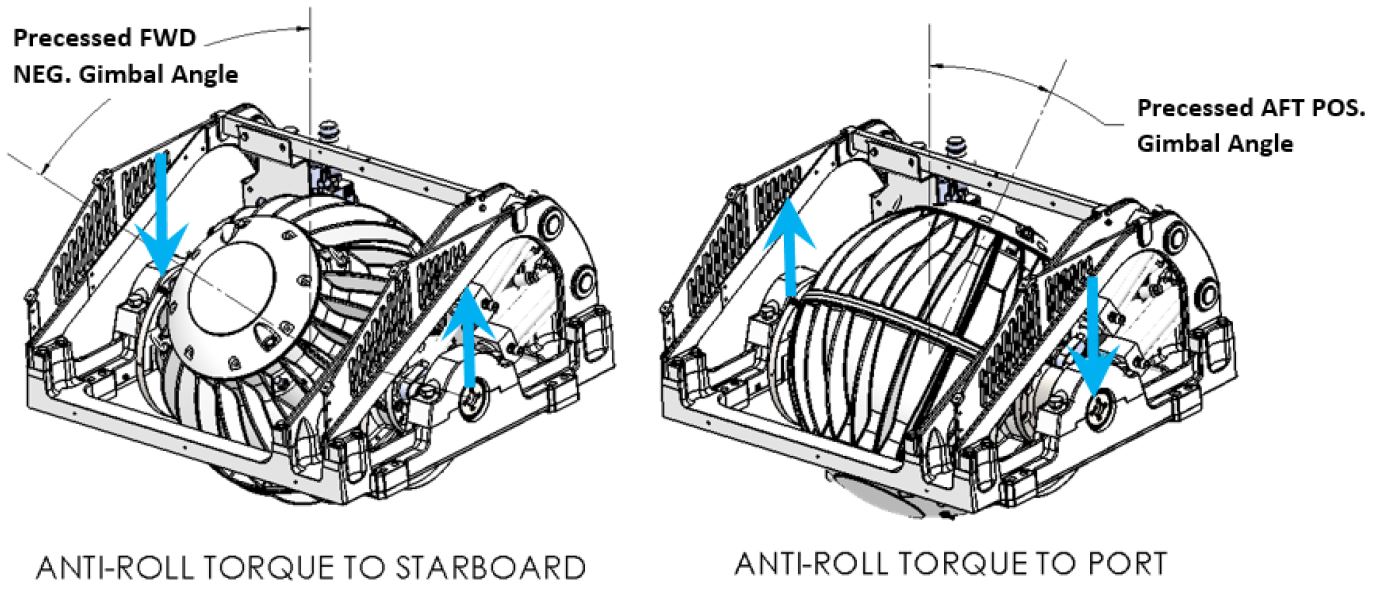
Seakeeper precession is actively controlled by an electronic controller and a hydraulic brake throughout each roll cycle so the Seakeeper supplies the maximum anti-roll torque and limits mechanical contact with the hard stops that limit the maximum gimbal angle travel to+/- 68 degrees.

There is a large torque about the gimbal axis when the Seakeeper is precessing. Seakeeper cover panels are provided to prevent personnel or equipment from contacting the Seakeeper while it is in operation. These covers should not be stood on or have anything placed on top. The covers should always be in place during operation. If it is ever necessary to touch the Seakeeper while the flywheel is spinning, the Seakeeper must be locked at the display to stop the Seakeeper from precessing. Seakeeper maintenance should not be attempted unless the Seakeeper is locked and the flywheel has stopped spinning.
Seakeeper Assembly
The Seakeeper assembly consists of a flywheel housed in a cast aluminum vacuum-tight enclosure. The flywheel spins about a vertical axis and is supported by upper and lower pairs of bearings. A DC brushless motor mounted inside the enclosure spins the flywheel at high speed.
The enclosure is fastened to two gimbal shafts that are supported by gimbal bearings on either side. These shafts establish an athwartship gimbal axis about which the flywheel and enclosure precess or rotate up to +/- 68 degrees during operation. The gimbal bearings are supported by a foundation which is attached to the hull structure. This foundation transfers the loads that the Seakeeper produces to the hull structure.
An active hydraulic brake mechanism is located on the Seakeeper assembly to regulate the Seakeeper’s precession motions about the gimbal shaft. It includes two hydraulic cylinders and a hydraulic manifold.
A coolant pump and heat exchanger with reservoir are located near the manifold. A glycol/water mix is circulated through a closed loop to the motor drive box, hydraulic manifold, and the end caps of the enclosure to remove heat.
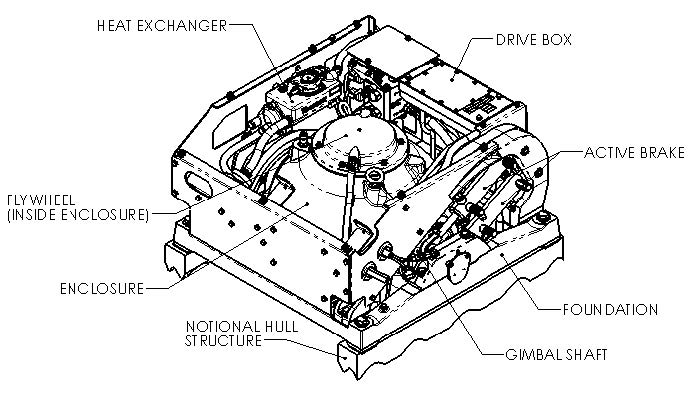
Display
The display shown below is the user interface to the Seakeeper 2 and should be mounted at the primary helm station. It is used to start, operate, monitor and shutdown the Seakeeper. Sensors, alarms and shutdowns are provided to allow unattended operation.
The display provides information in the event of an alarm. Alarms cause precession to stop(Stabilize Off) and the Seakeeper to start coasting down (Seakeeper Off).
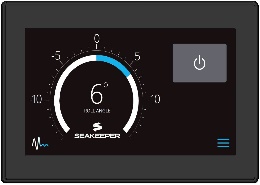
Drive Box
The glycol/water mix that cools the Seakeeper is also circulated through a cold plate inside the Drive Box to remove heat from high-power electronic components.

The Motor Drive Box contains an electrical hazard and the cover should not be removed while the flywheel is spinning and the DC input voltage is present. The electrical hazard exists even if the flywheel is coasting down and the supply voltage has been shut off. The flywheel must be at 0 RPM and DC input power disconnected for at least 10 minutes prior to any service work on the motor drive box.
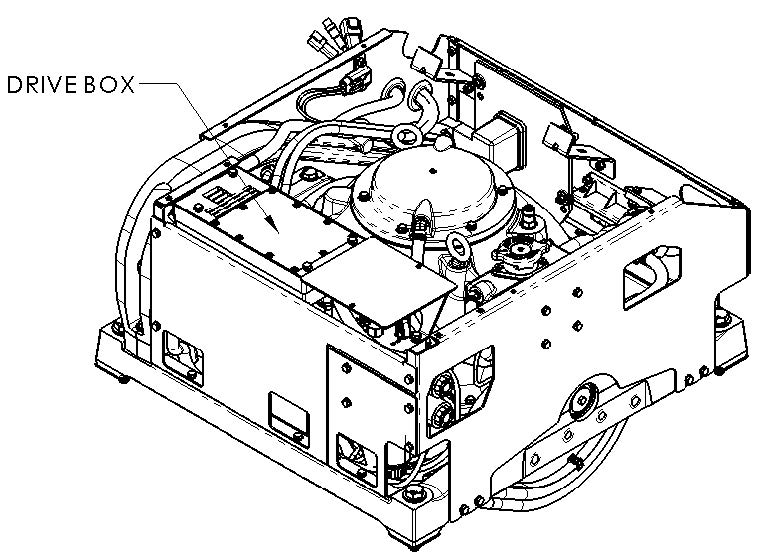
Electronic Control Module
The Electronic Control Module (ECM) monitors all the system sensors and automaticallyregulates operation of the Seakeeper.
The controller commands the motor speed and regulates the Seakeeper’s precession rate and angular position. This is accomplished by commands to a high response flow control valve in the hydraulic brake circuit that increases or decreases the precession rate.
Inertia Measurement Unit
The motion sensor suite in the Inertia Measurement Unit (IMU) measures the angular movements of the vessel and the vertical and lateral boat movement. These signals are communicated to the ECM through the
Seakeeper’s wiring harness.
Brake
The brake mechanism consists of two hydraulic cylinders that attach to a crank arm on the
Seakeeper gimbal shaft. The Seakeeper controller modulates how fast the oil can flow through the control valve thus controlling the precession rate of the Seakeeper.
The brake hydraulic circuit is a pre-charged closed loop – that is, there is no pump, motor or reservoir in the circuit. Accumulators are installed in the circuit to help maintain a more consistent pressure during operation and provide some make-up oil in the event of minor fluid loss. Locking solenoids are installed in the circuit to lock the Seakeeper so it cannot precess if there are any alarms or a mechanical problem with the Seakeeper.
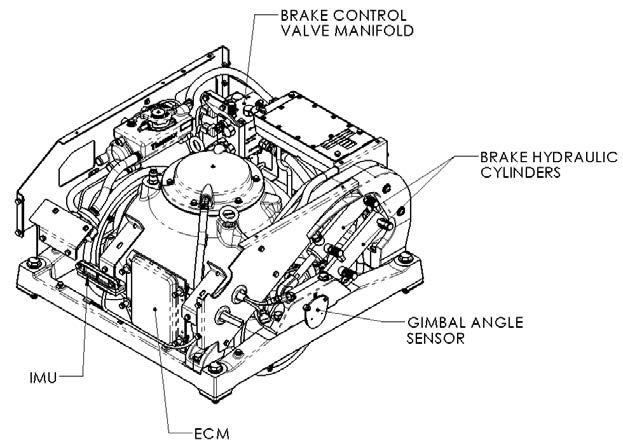
Hydraulic Hand Pump Kit is required for servicing the brake system (by a local Seakeeper dealer). Pressure should never be relieved unless this tool is available.
Cooling
The cooling circuit is a closed loop that supplies a glycol/water (50% distilled water and 50%glycol) mix to:
- The motor drive box to remove heat from the drive electronics
- The brake manifold to remove heat from the brake hydraulic circuit
- The enclosure water jackets to remove heat from the flywheel bearings
The heated fluid then passes through a heat exchanger that has seawater on the cold side. The seawater pump output will operate for two minutes after the Seakeeper is turned on. During operation, the seawater pump output is turned on and off based on the temperature of the Seakeeper. The circuit also contains a coolant reservoir for coolant expansion and to make filling easy. The reservoir contains a 7 psi (0.5 bar) pressure cap.
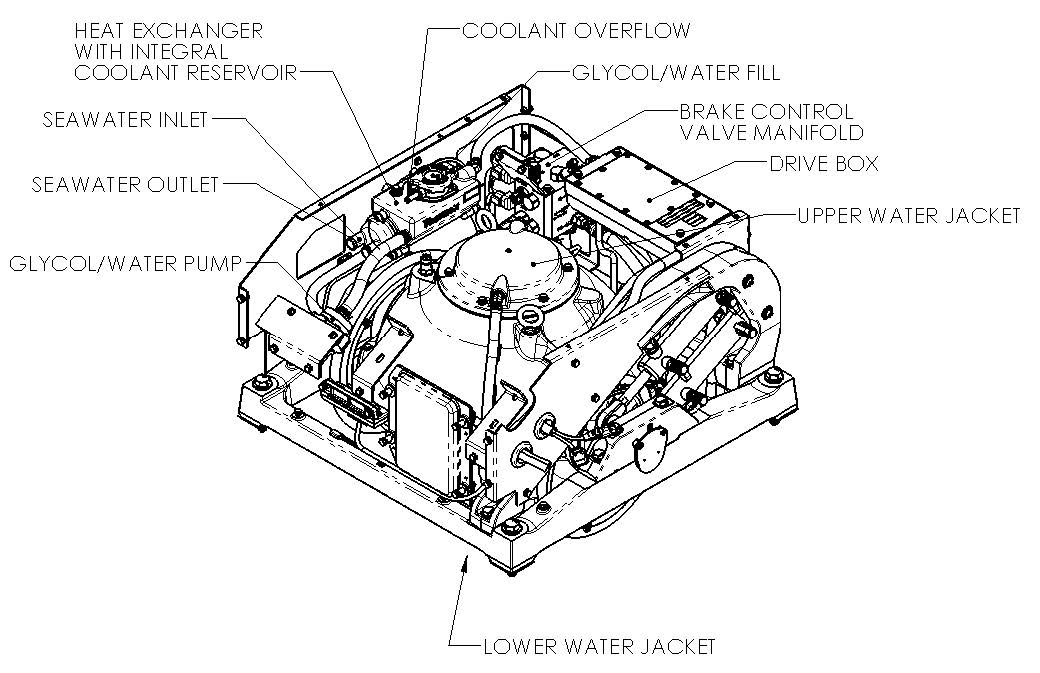
System Operation
Display Screens: Overview
Home Screen & Menu
- When 12 VDC power is applied to the Seakeeper, the display will power up and initialize. The splash screen will be displayed.

- After the display has initialized, the home screen will be displayed.
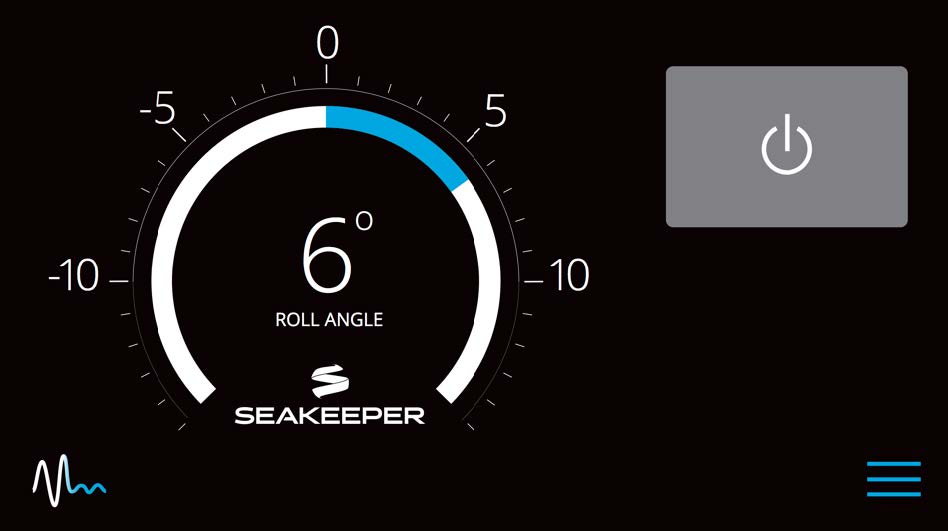
- The display uses a touch screen to allow users to select functions.

The button will change from grey (Seakeeper Off) to blue
(Seakeeper On)

The button will change from grey (Stabilize Off) to blue
(Stabilize On)

Angle Gauge and the Roll Angle Graph as shown below.
- When the menu button
 is pressed, the menu bar will appear or disappear at the bottom of the screen.
is pressed, the menu bar will appear or disappear at the bottom of the screen.

- The menu bar is used to navigate between pages. From left to right, the available pages are home, settings, information, service and alarm history. The selected page is highlighted in blue on the menu bar.

Settings Page
The Settings Page allows the user to adjust their preferences for the display. It can be accessed by pressing the gears ![]() in the menu bar.
in the menu bar.
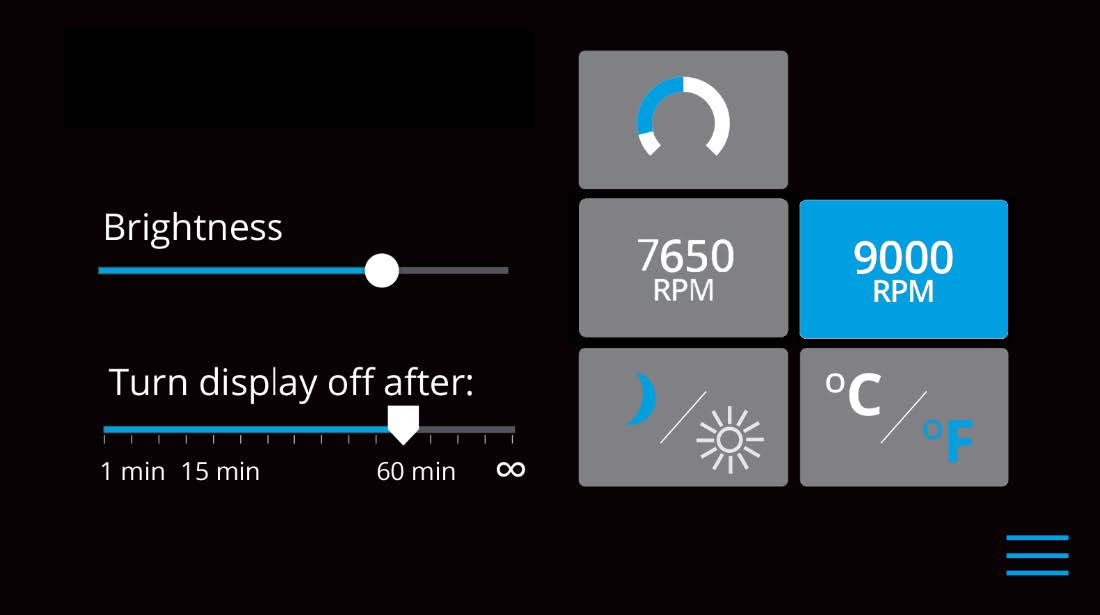
- To increase or decrease the brightness of the display, slide the white dot left to decrease brightness and right to increase brightness on the brightness bar, pictured below on the Settings Page.

- Adjust the sleep timer from 1 minutes to 60 minutes or on all of the time using sleeptime slider. Touching the screen will wake the display up after it has gone to sleep.

- Change the sign of the roll angle value displayed in the roll angle gauge so the gauge matches the motion of the boat. This will depend on installation orientation and will only need to be adjusted once. If the Seakeeper is facing the bow of the vessel, the Roll Angle Gauge should show the blue on the left (pictured left). If the Seakeeper is facing the stern of the vessel, you should select the Roll Angle Gauge with the blue on the right (pictured right). A positive roll angle should be displayed when the vessel rolls to starboard.

- Change the speed of the Seakeeper between normal operation and low power operation. Low power mode consumes less power and should generate less noise. The selected speed is colored blue. When power is cycled (or Seakeeper turned off), this speed will default back to the normal operating speed. Speed selection buttons shown below are examples and may not match operating speed of installed Seakeeper.
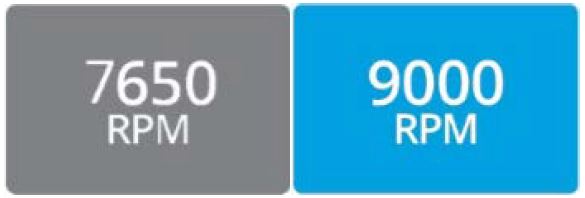
- Change the display between day and night mode. The selected mode is colored blue and to change between day and night mode, press the button.

- Change the units of the temperatures displayed on the Service Page between degrees Celsius and degrees Fahrenheit. The selected units are colored blue and to change between Celsius and Fahrenheit, press the button.

Information Page
- The Information Page
 displays the Seakeeper Model, Serial Number, Software Versions, Run Hours, Sea Hours, and other information. The image below is an example and may not match information details of installed Seakeeper.
displays the Seakeeper Model, Serial Number, Software Versions, Run Hours, Sea Hours, and other information. The image below is an example and may not match information details of installed Seakeeper.
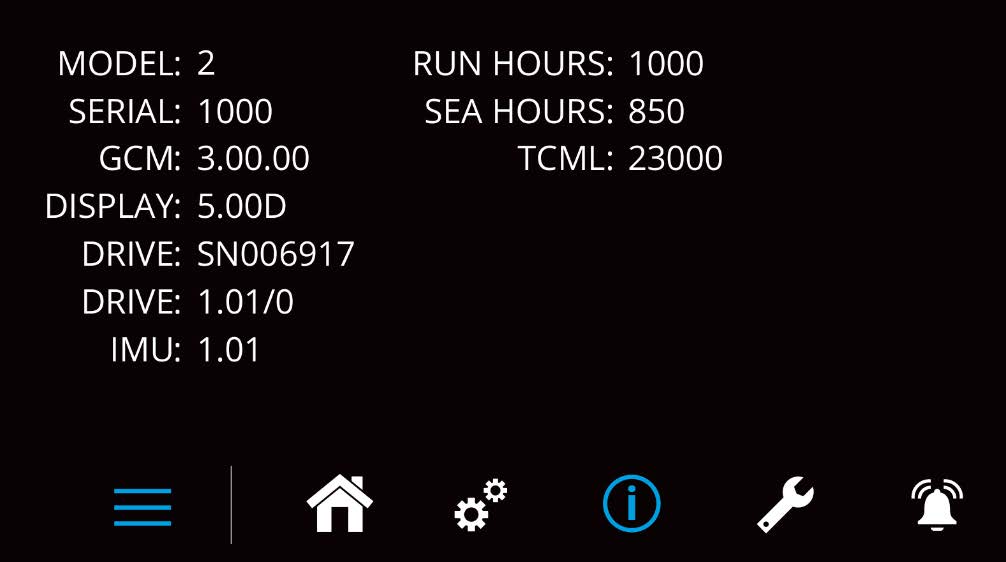
Service Page
- The Service Page
 displays Seakeeper operating information.
displays Seakeeper operating information.
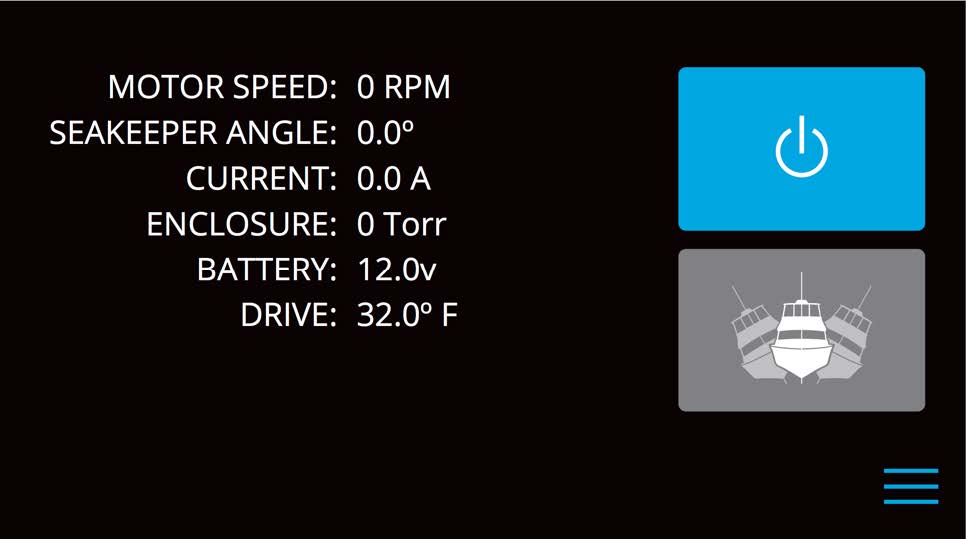
Alarm History Page
- The Alarm History Page
 shows alarms and warnings that have occurred in the past and their associated run hours. The scroll bar on the right is used to move up and down through the list.
shows alarms and warnings that have occurred in the past and their associated run hours. The scroll bar on the right is used to move up and down through the list.
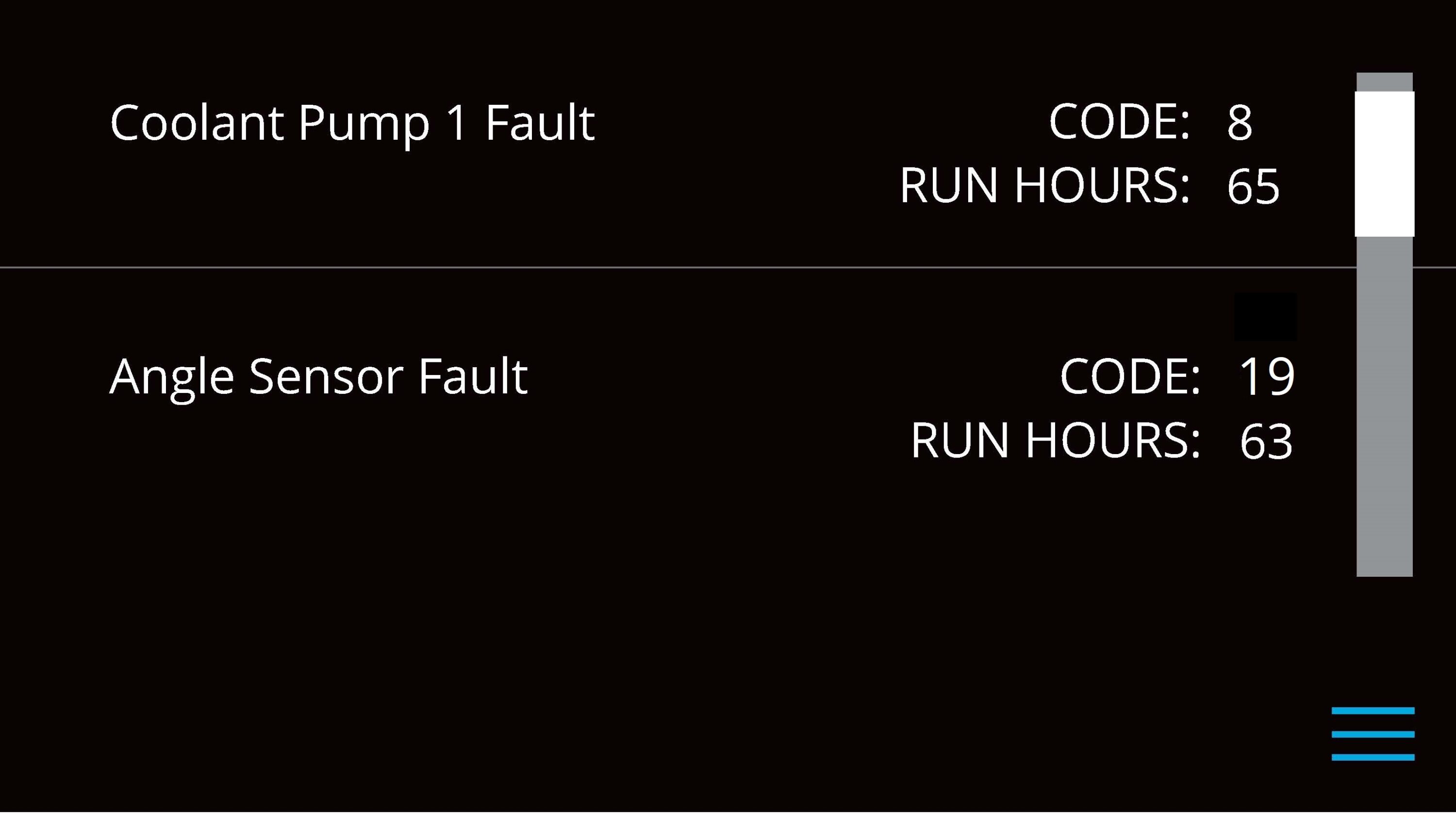
Start Up
- Make sure high current and low current DC inputs to the gyro are turned on.
- When the low DC power is turned on, the Display will initialize and the Home screen will appear.

- To turn the Seakeeper on, press the On/Off button, the button will turn blue. The progress bar will appear and indicate how soon the Seakeeper will be available for stabilization. When the Seakeeper is initialized and up to minimum operating speed the Stabilize button will appear. At this point, the Seakeeper is available for stabilization.


- When the Seakeeper reaches its maximum operating speed where maximum stabilization is available, the progress bar will disappear and the Seakeeper is available for maximum stabilization.

Stabilization
To stabilize the vessel after the Seakeeper is on and the flywheel is above the minimum stabilization RPM:
- Press the Stabilize button. The button will turn blue indicating that the Seakeeper is stabilizing the roll motion.


If it is necessary to shut off power to the flywheel motor and slow the flywheel for any reason, press Seakeeper On/Off button; the button will turn grey and the Stabilize button will disappear, indicating the command has been accepted. It takes approximately 16+ hours for the speed to slow down to 0 RPM.

If it is necessary to stop Seakeeper motion for any reason, press the Stabilize button. The Stabilize button will turn grey indicating that the Seakeeper is locked. Never attempt to work on the Seakeeper until the flywheel has stopped spinning. In the event that the brake system has automatically locked the Seakeeper due to an alarm or failure, no attempt should be made to bypass the alarm or automatic lock.
Normal Shutdown
The Seakeeper should be shut down when stabilization is no longer required. This maximizes the longevity of the Seakeeper.
- Press the Seakeeper On/Off button. The On/Off button will turn grey. The Seakeeper will discontinue stabilization and the flywheel will start coasting.

- Once the vessel is secured in the slip, switch the high current and low current DC power to the Seakeeper off. The flywheel will continue to spool down to 0 RPM. This can take16+ hours from full speed. When the flywheel has stopped spinning, 0 RPM will appearon the service screen.


Note: The seawater pump may run for up to 5 minutes after the Seakeeper is switched off and is coasting (with low current DC power applied).
The Seakeeper should be stopped when stabilization is no longer required. Once the vessel is secured in the slip, the high and low current DC power to the Seakeeper should be switched to the Off position. The Seakeeper will continue to spool down to 0 RPM. No cooling is required during this time. Note Seakeeper
will take 16+ hours to coast down to 0 RPMfrom full speed.
Power Failures, Alarms, and Troubleshooting
Power Failures
There are two sources of power to the Seakeeper 2:
- 12 VDC low current powers the Seakeeper for all the control electronics.
- 12 VDC high current powers the Motor Drive Box to drive the motor inside the Seakeeper.
These are supplied on Conductors 1 and 2 and Cable 7 which are shown on Drawing No.90470 – Seakeeper
2 Cable Block Diagram.

The Motor Drive Box contains a voltage hazard and the cover should not be removed while the flywheel is spinning or the DC input voltage is present. This voltage hazard exists even if the flywheel is coasting down and the supply voltage has been shut off. The flywheel must beat 0 RPM and DC input power disconnected for at least 10 minutes prior to any service work on the Motor Drive Box.
12VDC Low Current Failure
If the 12 VDC low current is disconnected during operation, the display will be blank, flywheel speed will decrease, and the Seakeeper will be turned off (no stabilization).
- Verify the boat’s circuit breaker or fuse supplying +12 VDC low current has not tripped or blown.
- When +12 VDC low current is restored, the display will power up, the Splash Screen will appear, and then the Home Screen will appear.
- Press Power On/Off button
 . The progress bar will appear and indicate flywheel speed. When the flywheel is at minimum operating speed, the Stabilize button will appear so stabilization can be turned on. This may take up to 30 minutes, depending on the speed of the flywheel when the +12 VDC low current is turned back on.
. The progress bar will appear and indicate flywheel speed. When the flywheel is at minimum operating speed, the Stabilize button will appear so stabilization can be turned on. This may take up to 30 minutes, depending on the speed of the flywheel when the +12 VDC low current is turned back on.
12VDC High Current Failure
If the 12 VDC high current is disconnected during operation, a notification screen will indicate “High Current DC Voltage Low”. If the failure is not corrected within two minutes, a “High Current DC Voltage Low” alarm will occur. The brake will lock.
- Verify the boat’s circuit breaker or fuse supplying +12 VDC high current has not tripped or blown.
- When +12 VDC high current is restored, the display will power up, the Splash Screen will appear, and then the Home Screen will appear.
- Press Power On/Off button
 . The progress bar will appear and indicate flywheel speed. When the flywheel is at minimum operating speed, the Stabilize button will appear so stabilization can be turned on. This may take up to 30 minutes, depending on the speed of the flywheel when the +12 VDC high current is turned back on.
. The progress bar will appear and indicate flywheel speed. When the flywheel is at minimum operating speed, the Stabilize button will appear so stabilization can be turned on. This may take up to 30 minutes, depending on the speed of the flywheel when the +12 VDC high current is turned back on.
Alarms
The Seakeeper issues an alarm when it detects a malfunction that could cause damage or erratic operation. When an alarm occurs, the Seakeeper will stop and an alarm message is shown on the Display.
The alarm will not clear until the operator presses the Reset Alarm button and the alarm condition is no longer present. The operator can then press the Power On/Off button again to continue Seakeeper operation.
- A view of a typical Alarm screen.
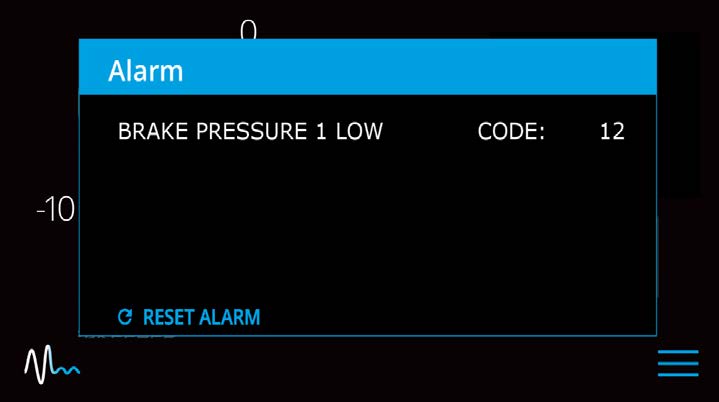
- To reset the alarm, press the Reset Alarm button:
 .
.
Alarm History
The Alarm History page on the Display shows the recent alarms and warnings. The alarms are in chronological order starting with the most recent. Warnings included in the history page are for issues that do not affect gyro operation.
Press the menu button ![]() to show the page options and then the Alarm button
to show the page options and then the Alarm button  to show alarm history.
to show alarm history.

Maintenance
Maintenance Introduction
The Seakeeper system is designed to require as little maintenance as possible. However, since the system is comprised of mechanical and electrical components that operate in a marine environment, some periodic inspections and maintenance are required. Seakeeper recommends a regular inspection interval and scheduled Maintenance to keep the Seakeeper running trouble-free.
If the Seakeeper is installed in a wet space, efforts should be made to keep the Seakeeper free of salt residue from either condensation or direct exposure to salt spray. If exposed, a regular wipe down with mild soap and water with a rinse will help limit corrosion and keep the Seakeeper assembly in good cosmetic condition. Refer to Fresh Water Rinse article on www.seakeeper.com, for details.
If any components of the Seakeeper or its sub-systems will be exposed to environmental temperatures where winterization is necessary for storage, reference Seakeeper Winterization Process article on www.seakeeper.com.
The Seakeeper comes standard with sealant and thread locker on applicable fasteners. When reinstalling all fasteners use thread locker and sealant unless otherwise specified.
Reference Documents
Precautions, Parts and Special Tools
Precautions

Hydraulic Hand Pump Kit is required for servicing the brake (by a local Seakeeper dealer). Pressure should NOT be relieved unless this tool is available.
Parts and Special Tools
All parts and special tools are available only to Seakeeper certified dealers. Find a local Seakeeper dealer at this link.
Scheduled Maintenance Table
This page contains the scheduled maintenance table organized by systems: Mechanical, Hydraulic, Cooling, and Electrical. Scheduled maintenance is not covered under warranty.
- Scheduled Maintenance should be performed by a Seakeeper trained factory technician or trained technician within the Seakeeper Dealer network. Find a local Dealer on our website at www.seakeeper.com/find-us/.
- A Seakeeper technician or Dealer is required to perform a brake service and to replace brake bushings or other brake components. This requires a complete flush, bleed, purge and pressurization of the closed hydraulic system.
- Scheduled Maintenance and the replacement of ‘wear’ items are not covered by the www.seakeeper.com/extended-warranty/recreation-warranty/.
| System / Component | Task | Interval | Parts / Special Tools |
|---|---|---|---|
| MECHANICAL / FOUNDATION | |||
| All Mounting Hardware | Inspect | 12 Months | |
| BRAKE SYSTEM | |||
| Hydraulic Manifold Components & Fittings | Inspect for leaks | 12 Months or 1000 Run-Hours | |
| Hydraulic Cylinders & Hoses | Inspect for leaks | 12 Months or 1000 Run-Hours | Hydraulic Hand Pump Kit |
| Hydraulic Accumulators | Replace | 2000 Run-Hours/As Needed | |
| Hydraulic Oil | Flush & Bleed | 1000 Run-Hours | |
| Brake Bushings | Inspect | 12 Months or 1000 Run-Hours | |
| Brake Bushings | Replace | 2000 Run-Hours/As Needed | |
| COOLING SYSTEM | |||
| Heat exchanger | Inspect for leaks | 12 Months or 1000 Run-Hours | |
| Heat Exchanger | Replace | 2000 Run-Hours/As Needed | |
| Heat Exchanger | Clean/Descale | 12 Months or 1000 Run-Hours | |
| Coolant Level-Glycol | Inspect/Fill | 12 Months or 1000 Run-Hours | Anti-freeze – 50/50 Ethylene Glycol mix. |
| Seawater Flow | Check seawater flow | 12 Months or 1000 Run-Hours | |
| Coolant Hoses | Inspect for leaks | 12 Months or 1000 Run-Hours | |
| Coolant Glycol | Inspect/Replace | 12 Months or 1000 Run-Hours | Anti-freeze – 50/50 Ethylene Glycol mix. |
| ELECTRICAL | |||
| Electrical Connections, Cables, and Components | Inspect for damage | 12 Months |
Warranty, Limit of Liability, and Property Rights
Warranty
The complete Seakeeper warranty details may be found on the Seakeeper website www.seakeeper.com.
Seakeeper Recreational Limited Warranty Policy
SEAKEEPER warrants that the Goods sold hereunder are free from defects in material and workmanship. This warranty is for the following period, whichever occurs first:
- 36 months (3 years) from the date of shipment from SEAKEEPER factory.
- 24 months (2 years) from date the product was put into service, which shall conclusively be presumed to be the date of sale of a vessel, on which a SEAKEEPER product is installed, to a retail customer or date put into service on an existing vessel (refit).
- Or, 2,000 (two thousand) operating SEA hours of use, subject to verification and confirmation by SEAKEEPER, INC.
All Seakeeper Models
BUYER IS SOLELY RESPONSIBLE FOR ENSURING THAT GOODS ARE PROPERLY LOCATED, INSTALLED AND MAINTAINED ON VESSEL’S HULL FOUNDATION WITH AN ADEQUATE MARGIN OF SAFETY, INCLUDING, BUT NOT LIMITED TO, COMPLIANCE WITH ANY SPECIFIED LOAD-BEARING REQUIREMENTS.
This warranty does not cover normal wear of the following components or the costs associated with maintenance, repair or replacement:
- Surface Corrosion (Cosmetic) on any component due to exposure
- Heat Exchanger
- Brake Bushings
- Isolation Bushings or Isolation Mounts
- Normal preventive and scheduled maintenance and component inspections/replacements as specified in the SEAKEEPER, INC., Operation Manuals and any other Maintenance Schedule documentation.
This express warranty is in lieu of and excludes: ALL OTHER WARRANTIES, EXPRESSED OR IMPLIED, BY OPERATION OF LAW OR OTHERWISE INCLUDING WARRANTIES OF MERCHANTABILITY OR FITNESS FOR A PARTICULAR PURPOSE (WHETHER KNOWN TO SELLER OR NOT), AND ALL OTHER SUCH WARRANTIES ARE HEREBY EXPRESSLY DISCLAIMED BY SELLER AND WAIVED BY CUSTOMER/END USER. SEAKEEPER, INC. SHALL IN NO EVENT BE LIABLE TO ANY SPECIAL, DIRECT, INDIRECT, INCIDENTAL OR CONSEQUENTIAL DAMAGES FOR BREACH OF ANY WARRANTY OR OTHER OBLIGATION ARISING OUT OF THE SALE OF THE PRODUCTS, OR FROM THE USE OF THE PRODUCTS OR ANY INABILITY TO USE THE PRODUCTS.
Written notice of claimed defects shall have been given to SEAKEEPER within the Warranty Period, and within thirty (30) days from the date any such defect is first discovered. The Goods or parts claimed to be defective must be returned to SEAKEEPER, accompanied by a Return Authorization (RA) issued by SEAKEEPER’s facility responsible for supplying Goods, with transportation prepaid by Buyer/User, with written specifications of the claimed defect.
If a warranty claim is valid, SEAKEEPER, INC. will repair or replace the Product, or part of the Product, proven to be defective, at its sole discretion, in a timeframe provided by SEAKEEPER, INC., on a reasonable best effort basis.
Under no circumstances shall SEAKEEPER be liable for removal of SEAKEEPER’s Goods from Buyer’s/User’s equipment or re-installation into Buyer’s/User’s equipment. No person including any agent, distributor, or representative of SEAKEEPER is authorized to make any representation or warranty on behalf of SEAKEEPER concerning any Goods manufactured by SEAKEEPER.
Warranty Activation
A Warranty Registration must be fully completed and sent to SEAKEEPER, INC., for review, approval and registration upon delivery of the vessel to the first retail customer. Warranty registration and expiration date confirmation can be achieved by providing SEAKEEPER, INC., a copy of the original bill of sale, purchase agreement, Owner’s name, address and SEAKEEPER Stabilizer Serial Number along with current RUN / SEA hours to SEAKEEPER’s warranty registration department within thirty (30) days of purchase. For removal of doubt, it is clarified that the activation date shall in no event affect the warranty period set forth herein.
“Owner” is defined as the first retail customer (purchaser), or subsequent customer (by transfer), of the SEAKEEPER Product as identified in SEAKEEPER warranty registration(s).
Limitation of Liability
NOTWITHSTANDING ANYTHING TO THE CONTRARY, SEAKEEPER SHALL NOT BE LIABLE FOR ANY SPECIAL, INCIDENTAL, INDIRECT OR CONSEQUENTIAL DAMAGES INCLUDING BUT NOT LIMITED TO LOST PROFITS ARISING OUT OF THE PERFORMANCE, DELAYED PERFORMANCE OR BREACH OF PERFORMANCE OF THIS ORDER REGARDLESS WHETHER SUCH LIABILITY BE CLAIMED IN CONTRACT, EQUITY, TORT OR OTHERWISE. SEAKEEPER’S OBLIGATION IS LIMITED SOLELY TO REPAIRING OR REPLACING (AT ITS OPTION AND AS SET FORTH IN SECTION 5), AT ITS APPROVED REPAIR FACILITY, ANY GOODS OR PARTS WHICH PROVE TO SEAKEEPER’S SATISFACTION TO BE DEFECTIVE AS A RESULT OF DEFECTIVE MATERIALS OR WORKMANSHIP, IN ACCORDANCE WITH SEAKEEPER’S STATED WARRANTY. IN NO EVENT SHALL SEAKEEPER’S LIABILITY EXCEED THE TOTAL PURCHASE PRICE SET FORTH IN THIS ORDER.
Property Rights
Except where otherwise expressly agreed, all patterns, tools, jigs and fixtures, drawings, designs, software and other materials and data developed, fabricated by Seakeeper shall be and shall remain Seakeeper‘s property. Except as specifically provided for in the order, Buyer shall have no right in any technical data, Intellectual Property Rights, and computer software associated with the order. Buyer shall not use or permit the use of the Goods that in any way could result in the disclosure of Seakeeper‘s proprietary information.
Specifications and Summary
| Seakeeper 2 | |
|---|---|
| Rated RPM | 9,000 RPM |
| Angular Momentum at Rated RPM | 2,000 N-m-s |
| Anti-Rolling Torque at Rated RPM | 5,249 N-m |
| Spool-up Time to Rated Speed | 35 minutes (9,000 RPM) |
| Spool-up Time to Stabilization | 24 minutes (7,650 RPM) |
| Spool-up Power DC Motor | 850 Watts Max |
| Operating Power DC (Sea state dependent) | 300-650 Watts |
| Voltage DC Input | 12 VDC @ 85 Amps (Spool-up) |
| Seawater Supply to Heat Exchanger | 2 GPM (7.6 LPM) minimum 6 GPM (22.7 LPM) maximum |
| Ambient Air Temperature | 32˚ – 140˚F (0 – 60˚C) |
| Weight | 414 lbs (188 kg) |
| Envelope Dimensions | 24.8 L x 25.5 W x 20 H (inches) 0.63 L x 0.648 W x 0.508 H (meters) |
| Noise Output | < 68 dBC at 1 meter |
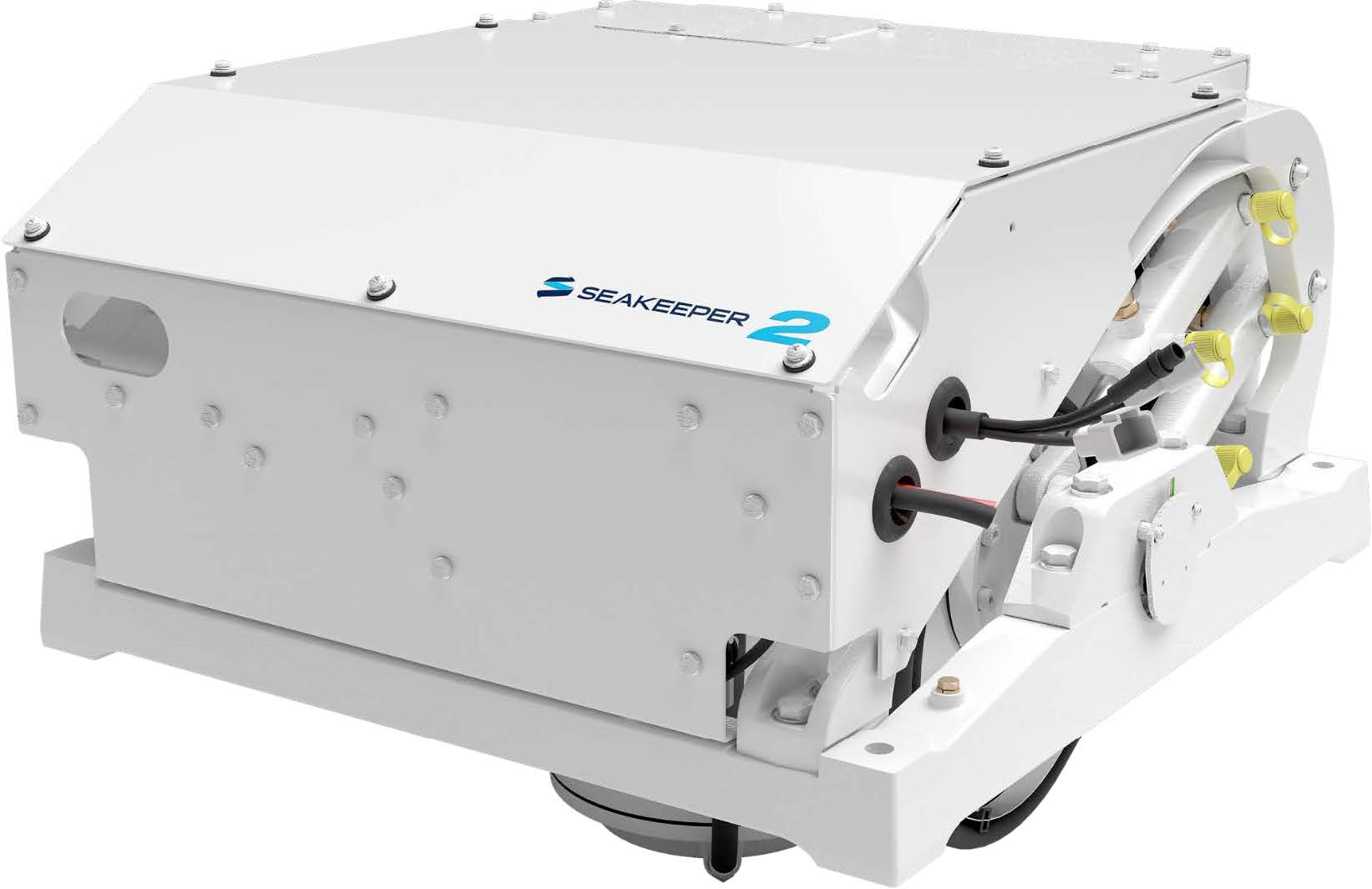
Arrangement
The Seakeeper 2 consists of the Flywheel, Enclosure, Foundation, Electronics, Brake, Cooling, and Cover Subsystems.
Installation Location
The Seakeeper is a torque device and does not have to be installed in a specific hull location or on the centerline. However, the Seakeeper should not be installed forward of the longitudinal center of gravity to minimize high acceleration loading due to hull/wave impacts during operation at high speed or in large waves.
Mounting Dimensions
See Drawing No. 90487 – Seakeeper 3 Bolt-In Installation Details.
Loads
The installer is responsible for designing the foundation to which the Seakeeper is attached and for ensuring that this foundation can safely transfer the concentrated Seakeeper loads from the frame to the adjacent hull structure. Loads that the Seakeeper imposes on the hull structure are explained on Drawing No. 90487 –
Seakeeper 2 Bolt-In Installation Details; these loads do NOT include vessel motion accelerations, such as vertical slam loads which can be high for higher speed vessels.
Cooling
The Seakeeper bearings, Motor Drive Box, and hydraulic manifold are cooled by a closed water / glycol mix cooling loop that incorporates a seawater heat exchanger. The installer is responsible for providing 2 – 6 GPM (8 – 22 LPM) raw water at ambient sea temperature and a maximum pressure of 20 psi (1.4 bar) to the heat exchanger.
Electrical
The installer is responsible for supplying 12 VDC at 100 A service to the Motor Drive Box and12 VDC at 15 A service to the Seakeeper Control System. Separate circuit breakers should be used for each Motor Drive Box in multiple Seakeeper installations. Similarly, separate circuit breakers should be used for each Seakeeper
Control System in multiple Seakeeper installations.
Operator Controls
A Touchscreen Display is used to start, operate, monitor, and shutdown the Seakeeper.
Performance
Reduction of boat roll is a function of the boat’s displacement, transverse metacentric height (GMT) and hull damping as well as the operating conditions (speed and heading with respect to waves) and sea state. The
Seakeeper controller regulates the active hydraulic brake to ensure the Seakeeper’s anti-roll torque is maximized regardless of hull characteristics or operating conditions.
Alarm and Monitoring
Sensors, alarms and shutdowns are provided to allow unattended operation. Sensors measure Seakeeper
and drive temperatures, vacuum pressure, gimbal angle, brake pressure, and ship motion. The Seakeeper
controller sends sensor values and alarm information to the display and also locks the brake and shuts down the motor drive in the event of an alarm condition. Seakeeper operating history during faults or alarms is recorded in the controller’s memory for subsequent recall if service is needed. Seakeeper may access the Seakeeper’s software to gather run hours, bearing loading, and hull slamming information.
Safety
The brake automatically locks the Seakeeper so it cannot generate excessive anti-rolling torque loads in the event of a system fault or alarm, loss of electrical power or loss of brake pressure. The brake can be locked from the Display or by shutting off AC and DC power at the supply breakers.